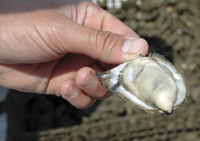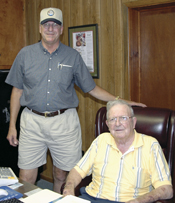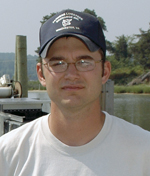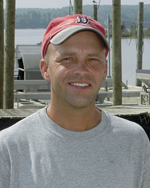Reinventing
the
Oyster
Story
and photos by Bill Sherrod, Editor
In
an unassuming setting on the banks of the Coan
River, a team of
Virginia
seafood proponents is working on a comeback plan.
|

Cowart
Seafood is located near Lottsburg, in Northumberland County, on
Virginia's Northern Neck. |
The lowly oyster once anchored � literally and figuratively �
Virginia�s mighty seafood industry.
This
crusty, bottom-dwelling bivalve and that more glamorous crustacean, the
blue crab, formed the foundation of the
Chesapeake Bay
�s once-flourishing commercial seafood trade. But this historically
prolific fishery has been on the decline for decades.
And
while the blue crab�s decline has slowed somewhat in recent years, the
oyster � besieged by disease, pollution, over-harvesting and predation
from blue crabs and the cownose ray � has all but disappeared from its
native territory.
Before
the oyster�s decline, vast reefs of oyster beds stretched across
thousands of acres of bay and river bottom along the Chesapeake Bay and
its tributaries in
Virginia
and
Maryland
. Subsequent generations of oysters took root on their ancestors�
shells, Nature�s blueprint for the perfect oyster-breeding habitat.
|

With
the help of a hydraulic knuckle-boom marine crane, workers heft an
oyster-laden growing cage from the bottom of the Coan River. |
Strategies
to restore the oyster to its historic prominence have made some headway. A
Northern Neck company � Cowart Seafood � is deeply involved in the
effort to reintroduce and propagate oysters in their historic range. Cowart
Seafood and Lake Packing Co. Inc. are situated on the Coan
River
near Lottsburg in
Northumberland
County. Lake Cowart Jr. manages both companies. His family has been in the
seafood and canning business since 1908.
Cowart
Seafood and Bevans Oyster Company in nearby Kinsale are working
cooperatively on a project to develop a method of growing oysters � or
�aquaculture� � that is commercially sustainable. They are working
to perfect a system that will provide enough fast-growing, sterile oysters
to keep their shucking houses in business.
In
a parallel effort, these two Northern Neck companies are working
cooperatively to produce fertile oysters to plant on public grounds, in
hopes of accelerating repopulation of the bay�s historic oyster
beds. �Oyster aquaculture has been in Virginia
for the past two decades,� notes A.J. Erskine, aquaculture manager and
field scientist for the project. �It isn�t new � we�re trying to
develop a way to produce more oysters, faster.�
A
key component in this effort has been development of a �floating
upweller� system for nurturing the oysters from the spat stage �
oyster infancy, so to speak � to a sort of adolescent phase of the
bivalves� development, when they can be put into growing cages and
placed in the Coan River to develop to harvestable size.
�We
started the aquaculture project in 2005, using a rack-and-bag system,�
notes Erskine The rack-and-bag procedure was successful and showed that
the temperature, salinity and other characteristics of the Coan
River
environs would, indeed, be favorable to growing oysters. To produce
oysters in the numbers needed to significantly supplement the Cowart
Seafood shucking and packing operation, however, a more prolific
off-bottom cage system was built.
|

The
development of a floating upweller has been a key part of the
effort to create a commercially sustainable oyster
population. |
The
floating-upweller system consists of a line of enclosed, submerged cages
attached to a floating platform. A large paddle-wheel is fixed at the
open, river end of the platform and keeps water and nutrients circulating
through the system of cages, which are filled with the tiny seed oysters.
The
sterile seed oysters come from several commercial hatcheries, including
one in Mathews, as well as from facilities located in
New England
and other locales. Sterile oysters are used because they grow faster �
there�s no energy wasted on reproduction � and a quality meat yield is
realized during summer months. The sterile oyster�s faster rate of
growth also lessens the likelihood that it will fall victim to the various
diseases that have decimated the bay�s oyster stocks.
The
oyster seedlings are miniscule � like grains of sand � when they first
arrive at Cowart Seafood. Before they can be placed into the floating-upweller
system, they are nurtured in an enclosed downweller system, where they
grow large enough to be placed in the more robust environment of the
floating upweller. "The upweller circulates oxygen- and
nutrient-rich water through the whole system using the large
paddle-wheel,� says Erksine. �It�s like having a high tide and a low
tide all at once.�
|

Lake
Cowart Jr. and his father, Lake Sr. - proprietors of Cowart
Seafood and Lake Packing -- are heavily involved in the effort.
The Cowart family has been in the seafood business for nearly a
century. |
It
takes four to eight weeks in the floating-upweller system to get a
�plantable� oyster, according to Erskine. When the young oysters reach
a size between � and one inch in length, they are �graded� and
separated out to be put into open-water cages located on private oyster
grounds in the Coan.
These
cages are 4-by-6-by-1 feet in dimension and hold about 10,000 seed oysters
each. The cages have been modified to allow a way out for small blue crabs
that have gotten in through the wire mesh. The conical escape route lets
the crabs find their way back into the open water, but doesn�t encourage
entry into the cage.
As
the oysters grow in these cages just off the river bottom, they are
checked regularly and separated out by size. Eventually, the cages hold
1,500 to 2,000 oysters when they�re ready to be harvested.
Once
the oysters are removed from the upweller and placed into the growing
cages in the Coan, it typically takes 12 to 18 months for the bivalves to
reach marketable size, about 3 inches in length. �We
planted about one million seed oysters in 2005, and harvested between
2,000 and 2,300 bushels in the fall of 2006,� Erskine continues.
After
harvest, the oysters are taken to Cowart Seafood Corporation for shucking,
packing and distribution. Cowart Seafood, for example, distributes a wide
variety of oyster products to grocery dealers across the nation.
|

Jason
Kenner, Cowart Seafood employee, works with Erskine on the
project. |
�We�re
working on increasing the volume of oysters that can be used in the
shucking houses,� notes Jason Kenner, an employee of Cowart Seafood who
works with Erskine on the oyster aquaculture project. �We sell oysters
frozen on the half shell, frozen breaded, in the shell, fresh shucked in
eight-ounce to one-gallon containers, and frozen shucked,�
Kenner
notes. "We can process as many as 10 million a year,� Erskine adds.
�The need is there, and we�re hoping to refine the process to meet
this demand.�
The
floating-upweller system is called an �intensive� form of aquaculture,
according to Erskine. A parallel part of the program is �extensive,�
and its goal is to produce fertile oysters that can be planted on public
oyster grounds and help to re-establish oysters in their historic breeding
areas.
The
extensive aquaculture system employs wide-mesh plastic bags filled with
oyster shells and submerged in tanks, through which raw river water is
pumped. Fertile oyster larva are introduced and �strike,� or set on the
shells. The shells are then taken out into the Chesapeake
or its tributaries and dropped on suitable oyster-breeding bottom on public
grounds. As well, sterile oyster larvae are set on shells and planted on
private grounds to further diversify aquaculture operations.
The
hope is that the fertile oysters will gain a foothold and be the genesis of
a growing native population.
This
would be good for the
Chesapeake Bay
and its tributaries for a number of reasons. Economically, it could help
begin the process of restoring the oyster to its once-lofty status at the
summit of the Virginia
seafood industry. This would mean more jobs for watermen, shuckers and
packers at the local seafood-processing plants, and more sales of locally
produced seafood across Virginia and the
U.S.
|

A.J.
Erskine is aquaculture manager and field scientist for the project. |
But
even more importantly, an expanding, self-propagating oyster population
could help restore the health of the bay itself. "Oysters
are a �keystone� species,� notes Erskine. �This means that the rest
of the bay�s health is linked to the health of the species.�
Erskine
says that a single 3-inch oyster can filter � purify � up to 50 gallons
of
Chesapeake Bay
water a day. And, before
Chesapeake Bay
oyster beds were depleted, a typical traditional oyster reef consisted of
millions of oysters. �Oysters
can help clear up algae � this would help to end the algae blooms that
have caused the �dead zones� in the bay in recent years,� he adds.
�It
could be a great story, and we�re hoping that what we�re doing here on
the Northern Neck will in some way help things along,� Erskine concludes.